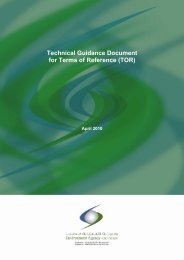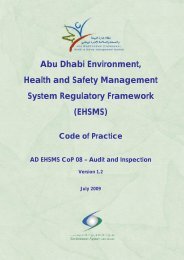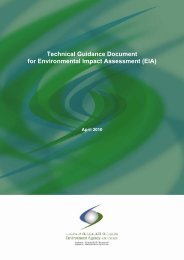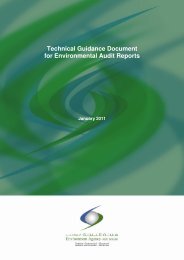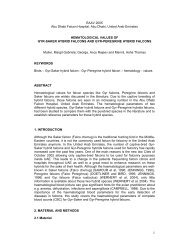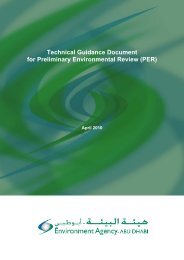Standard Operating Procedure (SOP) for Compliance Monitoring ...
Standard Operating Procedure (SOP) for Compliance Monitoring ...
Standard Operating Procedure (SOP) for Compliance Monitoring ...
You also want an ePaper? Increase the reach of your titles
YUMPU automatically turns print PDFs into web optimized ePapers that Google loves.
Application of the CEMS at Thermal Power Plants<br />
Testing requirements. Section 8 of PS-11 specifies the initial testing requirements <strong>for</strong> PM CEMS,<br />
which consist of a 7-day drift test and a correlation test. The 7-day drift test requires daily<br />
measurements of zero (low-level) and upscale drift measurements, which should be completed<br />
successfully be<strong>for</strong>e the correlation test is per<strong>for</strong>med.<br />
Unlike CEMS used to measure gaseous air pollutants, there are no calibration gases <strong>for</strong> checking the<br />
accuracy of PM CEMS. Instead, PM CEMS responses should be correlated to reference method<br />
measurements of PM concentrations. Consequently, the correlation test is the primary means <strong>for</strong><br />
evaluating the initial per<strong>for</strong>mance of a PM CEMS in monitoring PM emissions on a continuous basis.<br />
The test requires a minimum of 15 test runs. Each test run should include sampling PM using a<br />
manual reference test method with the simultaneous recording of PM CEMS responses. The reference<br />
test method should be the same method that is specified in the applicable regulation (e.g., U.S. EPA<br />
Methods 5, 5i, or 17). Section 8 of PS-11 also specifies the conditions under which additional<br />
correlation testing is required.<br />
Correlation requirements. Following completion of the correlation test, the PM CEMS response data<br />
should be correlated to the reference test method data using a regression analysis. Section 12 of PS-11<br />
specifies the procedures <strong>for</strong> per<strong>for</strong>ming the analysis. The outcome of the regression analysis is a<br />
correlation equation, which subsequently is used to determine the PM concentration that corresponds<br />
to a specific PM CEMS response. The correlation equation should satisfy criteria specified in Section<br />
13.2 of PS-11 <strong>for</strong> correlation coefficient, confidence interval half range, and tolerance interval half<br />
range. If the correlation equation does not satisfy all of these criteria, then additional correlation<br />
testing is required. In some cases, it may be necessary to relocate the PM CEMS or make other<br />
changes to the exhaust system to achieve an acceptable correlation.<br />
1.2.4.2 <strong>Procedure</strong> 2<br />
<strong>Procedure</strong> 2 requires a QC Plan that specifies procedures <strong>for</strong> routine operational checks and periodic<br />
audits of PM CEMS per<strong>for</strong>mance. This procedure specifies the minimum requirements <strong>for</strong> these<br />
checks and audits, which include the following:<br />
• Daily zero (or low-level) and upscale drift checks on all PM CEMS<br />
• For light-scattering or extinction-type instruments, daily checks of system optics<br />
• For extractive instruments that measure sample volume, daily sample volume checks.<br />
In addition to routine system checks, <strong>Procedure</strong> 2 requires several periodic audits, including the<br />
following:<br />
• For all PM CEMS, quarterly absolute correlation audits, which require comparison of PM<br />
CEMS responses to three audit points<br />
• For extractive instruments that measure sample volume, quarterly sample volume audits,<br />
which require comparison of sample volume measurements over three cycles to the volume<br />
measured using a calibrated device<br />
• For all PM CEMS, periodic relative response audits, which require comparison of PM CEMS<br />
responses to the results of three reference method test runs<br />
• For all PM CEMS, periodic response correlation audits (RCAs), which require comparison of<br />
PM CEMS responses to the results of 12 reference test method test runs.<br />
In the event that a PM CEMS fails any of these audits, PS-11 specifies the corrective actions that<br />
should be taken. If a system fails an RCA, a new correlation equation should be developed that<br />
satisfies all of the correlation criteria specified in PS-11.<br />
A1-12





